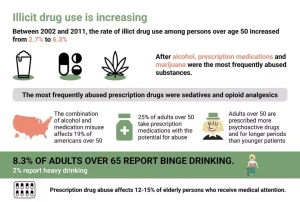
Acamprosate used in the treatment of alcohol dependence has demonstrated that its mechanism of action is through its inhibition of the NMDA receptor. Young males who have experienced a traumatic event can develop lowlevels of MAO‑A expression (an enzyme that breaks down serotonin), and this decrease in MAO‑A levels correlates with an increase in antisocial behaviour, which is a risk factor for alcohol dependence. “However, to my knowledge, these represent the first investigations of dopamine signals on sub-second timescales in humans with alcohol use disorder.” So, if you drink before the age of 14, there’s about a 50% chance you’re going to develop an alcohol use disorder in your adulthood,” explains Dr. Anand.
MECHANISMS OF ALCOHOL RELATED BRAIN INVOLVEMENT
Scientists have suggested that knowledge about the role of the neurotransmitter dopamine in the brain’s reward system may help fight the climate crisis. Scientists who study neurological and psychiatric disorders have long been interested in how dopamine works and how relatively high or low levels of dopamine in the brain relate to behavioral challenges and disability. Swedish pharmacologist and neuroscientist Arvid Carlsson won the Nobel prize in 2000 for his research on dopamine, showing its importance in brain function. The primary treatment for Parkinson’s disease is a drug called L-dopa, which spurs the production of dopamine.
Striatal activation to monetary reward is associated with alcohol reward sensitivity
This study showed that microinjection of either quinpirole or quinelorane, into the anterior part of the VTA dose‐dependently decreased alcohol, but not sucrose, intake in alcohol‐preferring rats [142]. In support are the data showing that local administration of cabergoline into the VTA reduced alcohol‐seeking behaviour in rats [170]. These data are contradictory to the findings showing that the dopamine D2 receptor antagonist into the anterior VTA did not alter alcohol intake in high‐alcohol‐preferring rats [142]. Therefore, mechanisms regulating alcohol reinforcement might be different in selectively breed high alcohol‐consuming rats compared to outbreed rats, and this should be investigated in more detail.

About the journal
Acute and chronic exposure to alcohol can have opposite effects on epigenetic regulation. For instance, while acute alcohol exposure increased histone acetylation and decreased histone methylation in the central amygdala (CeA), chronic intermittent exposure had opposite effects [20,21]. These findings suggest that the epigenetic landscape undergoes adaptations that might play an important role in the development of AUD. Fibre photometry for optical recording of neural activity in freely moving mice was conducted as described previously30,48. Briefly, a laser as excitation light source, a high sensitivity photoreceiver, and customised software for signal processing, were used.

Open Access is an initiative that aims to make scientific research freely available to all. It’s based on principles of collaboration, unobstructed discovery, and, most importantly, scientific progression. As PhD students, we found it difficult to access the research we needed, so we decided to create a new Open Access publisher that levels the playing field for scientists across the world. By making research easy to access, and puts the academic needs of the researchers before the business interests of publishers. These findings could explain why men are more than twice as likely as women to develop an alcohol use disorder. Parkinson’s disease and certain metabolic disorders, for instance, can deplete dopamine.
- As an important regulator of behavioral output, dysregulation of dopamine neurotransmission is implicated in theories of AUD development [13, 16, 35].
- Hebb has postulated a mechanism by which repeated synaptic input from a (predictor) cell that reliably precedes another (reward) neuron becomes linked to its target.
- Krystal J et al., The vulnerability to alcohol and substance abuse in individuals diagnosed with schizophrenia.
- Briefly, the dopamine affinity for the transporter (Km; set to 0.16 µM) was held constant and the dopamine peak height was determined empirically for each file and used for determination of Vmax (dopamine uptake rate), which was altered to best fit the empirically obtained dopamine transients.
- Therefore, CSS attenuated NAc DA signalling of reward anticipation in terms of DS causes response causes reward, whilst being without effect on NAc DA signalling of sucrose reward per se.
- Given that treatment-seeking individuals with AUD invariably go through repeated periods of abstinence and relapse, it is important for animal models of AUD to incorporate this element into the experimental design as these abstinence periods may contribute to the neurobiology of AUD.
- Learned behavior—perhaps all or almost-all learned behavior—depends on dopamine function; dopamine deficient animals fail to learn to search for food or other rewards and fail to learn to avoid predictable punishers.
- Some states have higher penalties for people who drive with high BAC (0.15 to 0.20 or above) due to the increased risk of fatal accidents.
- Traditional dopamine D2 receptor antagonists (so‐called neuroleptics, first‐generation antipsychotic drugs or typical antipsychotic drugs) are primary used for the treatment of psychosis, schizophrenia and bipolar disorder [11] based on their ability to counteract a heightened dopamine activity in the brain.
- Furthermore, reducing alcohol consumption to an average of 20 drinks per month rather than abstaining completely was sufficient to produce increases in brain volume compared with those who returned to patterns of heavy drinking that matched pre-treatment levels (consuming an average of 155 drinks per month) [25].
Importantly, the neurobiological basis of AUD appears in many cases to manifest in a sex-specific manner. Understanding convergence and divergence between mechanisms in males and females will continue to be critical moving forward [111,112]. Transcription factors often form large multimeric protein complexes that bind to target gene promoters or enhancers to regulate the expression of mRNA. Chronic alcohol exposure in rodents upregulates gene expression in neurons, astrocytes, and microglia [26–28], which raises the possibility that transcription factors serve as one of the master regulators of the neuroadaptations induced by alcohol. The mechanisms that drive alcohol-dependent transcriptional alterations are still being unraveled (Figure 1).
A major theme of recent alcohol research has been to leverage animal models and circuit-analysis approaches to link neural circuit activity with specific aspects of AUD [95]. For example, in mice, chronic alcohol exposure decreased the excitability of OFC outputs to the DMS [96], and alcohol-induced synaptic plasticity in the OFC has been linked to excessive alcohol use in both mice alcohol dopamine and monkeys models [97,98]. In addition, using a combination of activity dependent genetic tools and chemogenetic manipulations, a small ensemble of mPFC neurons was shown to serve as a memory to cue induced relapse to alcohol use [99]. Interestingly, like the molecular mechanisms that gate the development of AUD [3], STOP mechanisms also occur on the level of circuitries [100].
- It is noteworthy that the ACC and FIC––the prefrontal brain regions for which increased FC following P/T depletion mediated AB in this study––are major hubs of the salience network that is involved in conditioning and assigning incentive salience to drugs and drug-related cues [112].
- LTP is a sudden but lasting increase in the overall level of excitatory neurotransmission in the hippocampus, a brain region involved in memory.
- So, if you drink before the age of 14, there’s about a 50% chance you’re going to develop an alcohol use disorder in your adulthood,” explains Dr. Anand.
- Recently, two sub types of the GABAA receptor have come into the spotlight for showing what can possibly be a genetic predisposition to alcohol addiction.



